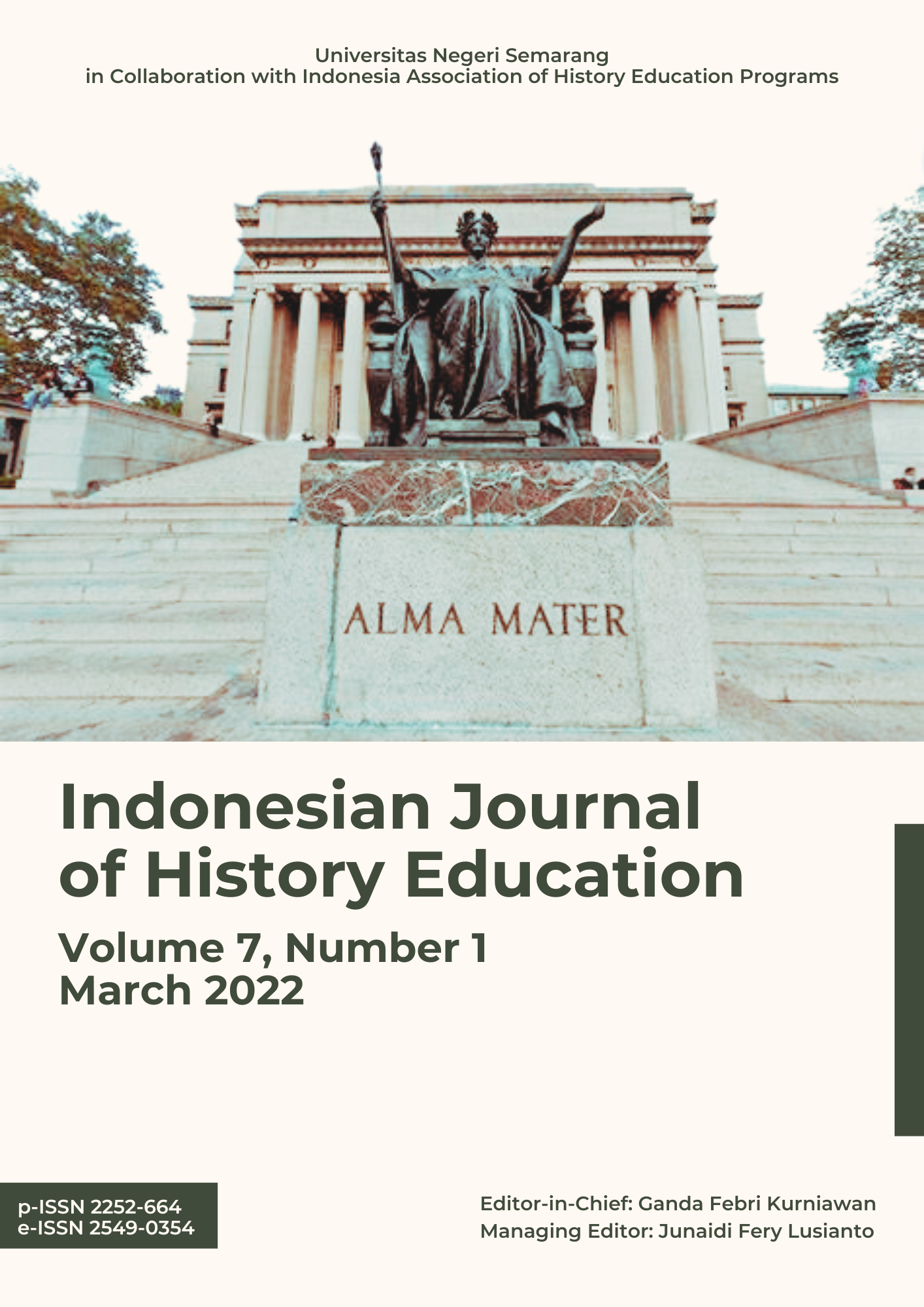Development of Teaching Materials Handout Material KH. Ahmad Rifa'i in Learning the History of the Indonesian Independence Struggle at SMA Negeri 1 Bandar
Abstract
This study aimed to analyze the historical teaching materials needed in 1 Bandar High School to develop teaching materials in KH. Ahmad Rifa'i, and the feasibility of KH handout material. Ahmad Rifa'i. The method used in this study is research and development with development models developed by Thiagarajan, Semmel, and Semmel. This research goes through four steps: defining, planning, developing, and disseminating. The study results show that (1) Learning history in SMA 1 Bandar has used teaching materials consisting of LKS and modules available at school. Teaching materials regarding KH still need to be added to the material. Ahmad Rifa'i. Requires teaching material about the material; (2) Development has been carried out with four steps, namely defining, designing, developing, and implementing; (3) Based on the level of feasibility of the results of the validation of material experts and media experts, the developed handouts showed 82.4% for material validation and 83.1% for media validation. In addition, the results of the teacher's response were 87.2%, and the results of the students' response were 96.7%. Learning to obtain teaching materials is worth using in history learning at school.
References
Abidin, Y. (2016). Desain Sistem Pembelajaran dalam Konteks Kurikulum 2013. Bandung: Refika Aditama.
ARIFIN-NIM, Z. A. I. N. A. L. (2010). Kritik sosial dalam wacana fiqih (Telaah atas pemikiran fiqih pernikahan Kh. Ahmad Rifa’I Kalisalak) (Doctoral dissertation, UIN Sunan Kalijaga Yogyakarta).
Atno. (2010). Meningkatkan Hasil Belajar Sejarah Siswa Melalui Pendekatan Pembelajaran Konstekstual dengan Media VCD Pembelajaran. Dalam Paramita Historical Studies Journal Vol. 20 No.1.
Aziz, M. (2015). Konsep Peradaban Islam Nusantara: Kajian atas Pemikiran Syekh Ahmad Mutamakkin (1645-1740) dan KH Sahal Mahfudz (1937-2015). Jurnal Lektur Keagamaan, 13(2), 455-474.
Daryanto dan Dwicahyono A. (2014). Pengembangan Perangkat Pembelajaran. Yogyakarta: Gava Media.
Djamil, A. (1999). KH. Ahmad Rifa’i Kalisalak; Studi Tentang Pemikiran dan Gerakan Islam Abad Sembilan Belas (1786–1876) (Doctoral dissertation, UIN SUNAN KALIJAGA YOGYAKARTA).
Faza, I. A. (2021). Seni sebagai Media Dakwah (Kajian Pemikiran Dakwah KH. Ahmad Rifa’i [W. 1286 H/1878 M] dalam Kitab Ri ‘āyah al-Himmah).
Hasan, S. H. (2012). Pendidikan Sejarah untuk Memperkuat Pendidikan Karakter. Paramita Historical Studies Journal Vol.22 No.1.
Iswanto, A. (2017). Tradisi Islam, Tradisi Arab dan Tradisi Jawa: Membaca Karya dan Pemikiran KH Ahmad ar-Rifai Kalisalak. Jurnal Lektur Keagamaan, 15(2), 514â-527.
Jamil, A. (2001). Perlawanan Kiai Desa: Pemikiran Dan Gerakan Islam K. H. Ahmad Rifa’i. Jakarta: LKIS.
Jantari, K. H., Bain, B., & Romadi, R. (2019). Pengembangan Bahan Ajar Handout Materi KH. Ahmad Rifa'i Dalam Pembelajaran Sejarah Perjuangan Kemerdekaan Indonesia di SMA Negeri 1 Bandar. Indonesian Journal of History Education, 7(1), 40-49.
Lova, L. E., & Budiwati, A. (2021). Pemikiran KH. Ahmad Rifa’i tentang Walimatul Ursy pada Jami’ah Rifaiyah di Desa Sundoluhur, Kayen, Pati. al-Mawarid Jurnal Syariah dan Hukum (JSYH), 3(2), 119-134.
Munib, A., dkk. (2004). Pengantar Ilmu Pendidikan. Semarang: UPT UNNES Press.
Nikah, K. W. Konsep Wali Nikah (Analisis Pemikiran KH. Ahmad Rifa’i Relevansinya dengan Kompilasi Hukum Islam Pasal 19-23).
Noviani, N. L., Maknun, M. L., Iswanto, A., & Ruchani, B. (2021). Naskah-Naskah Karya KH Ahmad Rifa'i Kalisalak di Kabupaten Wonosobo. Jumantara: Jurnal Manuskrip Nusantara. Vol. 12. No. 2. Hal. 227, 241.
Prastowo, A. (2012). Panduan Kreatif Membuat Bahan Ajar Inovatif.
Romadi dan Kurniawan, G. (2017).
Sudrajat, A. (2017). KH Ahmad Rifa’i Dari Kalisalak Pekalongan dan Gerakan Protes Sosial Abad 19. nd https://staffnew. uny. Ac. id/upload/131862252/penelitian/KH+ Ahmad+ Rifai+ dan+ Gerakan+ Ptotes+ Sosial. Pdf.
Supala, S., Handayani, D., & Rifai, A. (2020). Pendidikan Humanis Kh Ahmad Dahlan, Ki Hajar Dewantara Dan Paulo Freire. THORIQOTUNA: Jurnal Pendidikan Islam, 3(2), 94-115.
Supardi, S. (2006). Pendidikan Sejarah Lokal Dalam Konteks Multikulturalisme. Cakrawala Pendidikan, Februari 2006, Th. XXV, p. 1.
Suparno, D. (2016). Deiksis” dalam Nazam Tarekat Karya KH Ahmad Ar-Rifai Kalisasak: Tinjauan Pragmatik. Dialektika: Jurnal Bahasa, Sastra, Dan Pendidikan Bahasa Dan Sastra Indonesia, 3(2), 153-172.
Thiagarajan, S., Sammel, D.S., and Sammel, M. I., (1974). Instructional Development For Training Teachers of Exceptional Children. Leadership Training Institute/Special Education, Minnesota: University of Minnesota, Minneapolis.
Yakin, A. U. (2016). Fatwa Kh. Ahmad Rifa’I Kalisalak tentang opium dan rokok di Jawa abad XIX fatwa of Kh. Ahmad Rifa’I Kalisalak on opium and smoking in 19th century Java. Jurnal Masyarakat dan Budaya, 18(1), 19-32.
Yogyakarta: DIVA Press.
Copyright (c) 2022 Indonesian Journal of History Education

This work is licensed under a Creative Commons Attribution 4.0 International License.
Copyright Notice
An author who publishes in the Jurnal Indonesian Journal of History Education agrees to the following terms:
- Author retains the copyright and grants the journal the right of first publication of the work simultaneously licensed under the Creative Commons Attribution-ShareAlike 4.0 License that allows others to share the work with an acknowledgement of the work's authorship and initial publication in this journal
- Author is able to enter into separate, additional contractual arrangements for the non-exclusive distribution of the journal's published version of the work (e.g., post it to an institutional repository or publish it in a book) with the acknowledgement of its initial publication in this journal.
- Author is permitted and encouraged to post his/her work online (e.g., in institutional repositories or on their website) prior to and during the submission process, as it can lead to productive exchanges, as well as earlier and greater citation of the published work (See The Effect of Open Access).
Read more about the Creative Commons Attribution-ShareAlike 4.0 Licence here: https://creativecommons.org/licenses/by-sa/4.0/.




